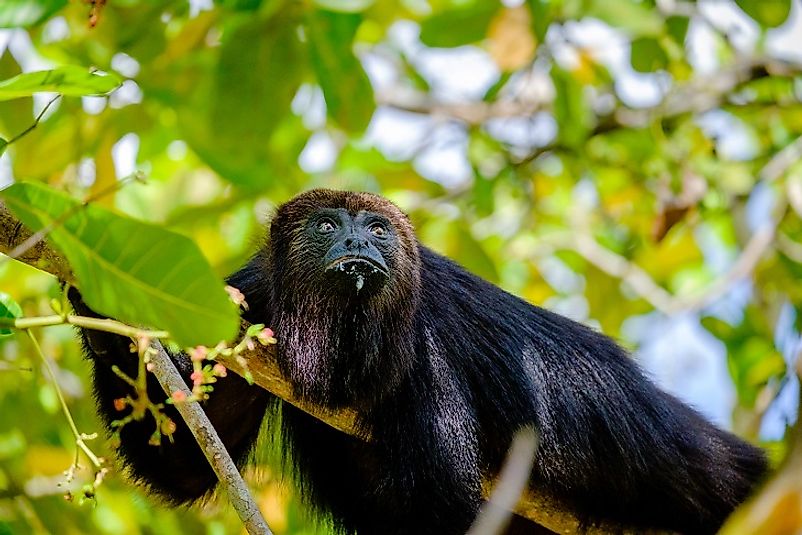Threatened Mammals Of Guatemala

Guatemala is a country in Central America along the southern border of Mexico, and is officially known as the Republic of Guatemala. Its capital, Guatemala City, which is also the largest city, is also home to the National Palace of Culture and the National Museum of Archaeology and Ethnology. Guatemala is the most populous nation in South America with a population of approximately 15.8 million, and an area covering 42,042 square miles. There are a vast number of mammals endangered in the country and are discussed in detail below.
Greater Long-Nosed Bat
The greater long-nosed bat, also known as Mexican long-nosed bat, is scientifically known as Leptonycteris nivalis. It is a species of bat family found in Guatemala with a total body length of 2.75 to 3.75 inches. It could be dark gray to brown in color with a long tongue for feeding on flower nectar. Its natural habitat is temperate forest and faces a major threat due to loss of habitat and very little regarding their habits is known as they migrate due to seasonal changes and the availability of food. These bats are the pollinators of the blue agave plant and rely on the plant’s pollen grains and nectar. They give birth during midsummer where the female species gather in large nursery colonies while during late summer, both male and female species roost in the caves of southern Mexico.
Guatemalan Black Howler Monkey
Alouatta pigra is the scientific name for the Guatemalan black howler monkey, which is sometimes referred to as the Yucatan howler or the Yucatan black howler. The male species are larger than any other Central American monkey species, and they weight almost twice the weight of the female species. Both the female and male have a general body length between 20.5 to 25.2 inches with long black hair while infants have brown fur. It feeds mainly on leaves, and the molars have high shearing crests adapted to its diets. They live in the evergreen, semi-deciduous and lowland rainforests in groups of around five monkeys where females are more. Females reach their sexual maturity earlier at four years as compared to males at six to eight years old. Their major threats include hunting, habitat loss and being captured as pets and efforts are being made to make reserves for their safety.
Baird’s Tapir
The Baird’s tapir is also known the Central American tapir, and scientifically known as Tapirus bairdii. They are found in forested areas with ponds and streams, such as in the wet tropical rainforests. There is a decline in their population is due to hunting and destruction of their habitat while their vulnerability is increased due to that fact that they have a low reproductive rate. Conservation actions, including the construction of protected habitats such as reserves, could decrease the decline in population by a greater margin.
Derby’s Woolly Opossum
The Derby’s woolly opossum, or the Central American woolly opossum, is scientifically named Caluromys derbianus, and it is the largest of the woolly opossum species. It has a long slender body and the woolly coat which exhibits considerable variation ranging from pale gray to bright reddish brown. Its limbs are lighter with buff-white underparts and have a long tail which is only furred up halfway, and the other half is naked. The tail gives it balance and grip together during hunting. It lives in the treetops of the rainforest and is well adapted to this habitat, for instance, having binocular vision which enables and excellent hand-eye coordination and depth perception important for its navigation through tree tops this is because of its forward-directed eyes.
West Indian Manatee
The West Indian manatee is commonly known as the sea cow, and its scientific name is Trichechus manatus. It’s the largest member of the aquatic mammal and is divided into two subspecies, the Florida manatee, and the Antillean or Caribbean manatee. The Florida manatee is larger in size than the Antillean manatee, and that’s the only slight difference between the two. The West Indian manatee is fully adapted to the aquatic lifestyle with no hind limbs. There’re no algae build up on their skin as pelage cover is sparsely distributed on its skin. It is around 11 feet long and weighs up to 1,300 pounds, with females being larger than the males. The sea cow lives in the shallow coastal areas of the West Indies and the Caribbean Sea, and can withstand large changes in water salinity. Their gestation period of a mature female is 12 to 14 months, and young are born with molars which enable them to feed on sea grass after three weeks of birth. These two
Threats to the Mammals of Guatemala
Poaching is the greatest threat facing the mammals of Guatemala. The West Indian manatee subspecies are hunted for meat and hide, and anti-poaching rules have been established to reduce the risks. The Derby’s woolly opossum is facing loss of its forest habitat while in the past the major threat was hunting for its fur, the hunting was banned by the government in a bid to save their existence.
Threatened Mammals Of Guatemala
| Threatened Mammals of Guatemala | Scientific Name |
|---|---|
| Nelson's Spiny Pocket Mouse | Heteromys nelsoni |
| Maya Mouse | Peromyscus mayensis |
| Guatemalan Myotis Bat | Myotis cobanensis |
| Guatemalan Black Howler Monkey | Alouatta pigra |
| Greater Long-Nosed Bat | Leptonycteris nivalis |
| Baird's Tapir | Tapirus bairdii |
| West Indian Manatee | Trichechus manatus |
| Honduran Small-Eared Shrew | Cryptotis hondurensis |
| Derby's Woolly Opossum | Caluromys derbianus |
| Southern Long-Nosed Bat | Leptonycteris curasoae |











